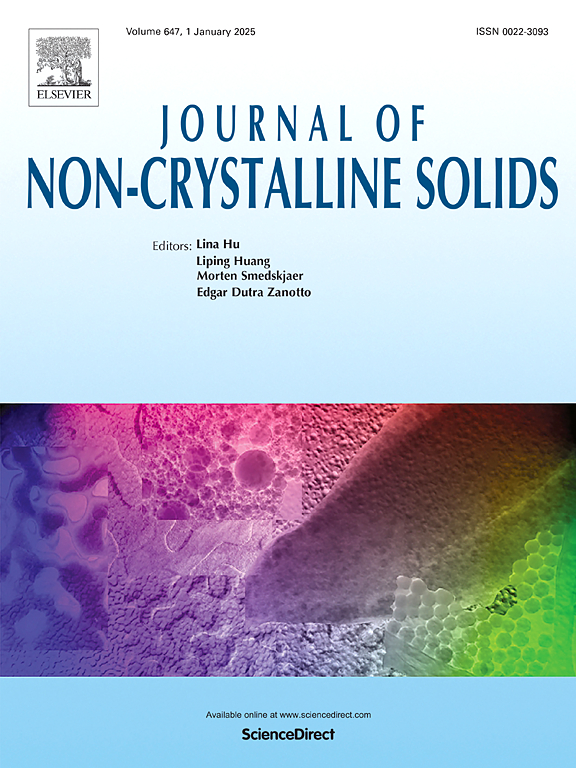The Network structure and viscoelastical-rheological properties of multicomponent aluminosilicate glass
IF 3.5
3区 材料科学
Q1 MATERIALS SCIENCE, CERAMICS
引用次数: 0
Abstract
In this work, we investigate the structure and viscoelastic rheological properties of multicomponent aluminosilicate glasses with Al/(Si+Al) ratios ranging from 0.37 to 0.52. It is found that an increase in the Al/(Si+Al) ratio enhances the connectivity of the glass network, leading to the enhancement of glass transition temperature Tg (661.8–690.2 °C), softening temperature Td (725.5–744.9 °C), and high-temperature viscous activation energy (VAE) (165.02–190.13 kJ/mol). With increasing Al/(Si+Al) ratio, the coefficient of thermal expansion (CTE) first decreases and then increases, reaching a minimum of 7.196 × 10–6 1/K when the Al/(Si+Al) ratio is ∼0.45. Meanwhile, the fragility index (m) and operational temperature range reach the maximum and minimum values of 36.97 and 232.7 °C, respectively. Viscoelastic properties of glass show a strongly dependent on the Al/(Si+Al) ratios. At Al/(Si+Al) ratios of 0.37, 0.41, and 0.49, both the loss angle tanθ and relaxation time decrease and then increase, with values of 0.41, 0.34, and 3.17, and 0.0624, 0.0516, and 0.2014 s, respectively. The variations in the loss angle and relaxation time suggest that the network connectivity alone does not fully account for the viscoelastic properties of glass.
多组分铝硅酸盐玻璃的网络结构及粘弹性流变学性能
在这项工作中,我们研究了Al/(Si+Al)比为0.37 ~ 0.52的多组分铝硅酸盐玻璃的结构和粘弹性流变性能。结果表明,Al/(Si+Al)比的增加增强了玻璃网络的连通性,导致玻璃化转变温度Tg(661.8 ~ 690.2℃)、软化温度Td(725.5 ~ 744.9℃)和高温粘性活化能(VAE) (165.02 ~ 190.13 kJ/mol)的提高。随着Al/(Si+Al)比的增大,热膨胀系数(CTE)先减小后增大,当Al/(Si+Al)比为~ 0.45时达到最小值7.196 × 10 - 6.1 /K。同时,脆性指数(m)和工作温度范围分别达到最大值36.97和最小值232.7℃。玻璃的粘弹性性能与Al/(Si+Al)比密切相关。在Al/(Si+Al)比为0.37、0.41和0.49时,损耗角tanθ和弛豫时间先减小后增大,分别为0.41、0.34和3.17,0.0624、0.0516和0.2014 s。损失角和松弛时间的变化表明,网络连通性本身并不能完全解释玻璃的粘弹性特性。
本文章由计算机程序翻译,如有差异,请以英文原文为准。
求助全文
约1分钟内获得全文
求助全文
来源期刊

Journal of Non-crystalline Solids
工程技术-材料科学:硅酸盐
CiteScore
6.50
自引率
11.40%
发文量
576
审稿时长
35 days
期刊介绍:
The Journal of Non-Crystalline Solids publishes review articles, research papers, and Letters to the Editor on amorphous and glassy materials, including inorganic, organic, polymeric, hybrid and metallic systems. Papers on partially glassy materials, such as glass-ceramics and glass-matrix composites, and papers involving the liquid state are also included in so far as the properties of the liquid are relevant for the formation of the solid.
In all cases the papers must demonstrate both novelty and importance to the field, by way of significant advances in understanding or application of non-crystalline solids; in the case of Letters, a compelling case must also be made for expedited handling.
 求助内容:
求助内容: 应助结果提醒方式:
应助结果提醒方式:


